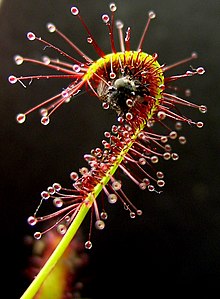
Drosera, which is commonly known as the sundews, is one of the largest genera of carnivorous plants, with at least 194 species. These members of the family Droseraceae lure, capture, and digest insects using stalked mucilaginous glands covering their leaf surfaces. The insects are used to supplement the poor mineral nutrition of the soil in which the plants grow. Various species, which vary greatly in size and form, are native to every continent except Antarctica.

Droseraceae is a family of carnivorous flowering plants, also known as the sundew family. It consists of approximately 180 species in three extant genera. Representatives of the Droseraceae are found on all continents except Antarctica.

The Venus flytrap is a carnivorous plant native to the temperate and subtropical wetlands of North Carolina and South Carolina, on the East Coast of the United States. Although various modern hybrids have been created in cultivation, D. muscipula is the only species of the monotypic genus Dionaea. It is closely related to the waterwheel plant and the cosmopolitan sundews (Drosera), all of which belong to the family Droseraceae. Dionaea catches its prey—chiefly insects and arachnids—with a "jaw"-like clamping structure, which is formed by the terminal portion of each of the plant's leaves; when an insect makes contact with the open leaves, vibrations from the prey's movements ultimately trigger the "jaws" to shut via tiny hairs on their inner surfaces. Additionally, when an insect or spider touches one of these hairs, the trap prepares to close, only fully enclosing the prey if a second hair is contacted within (approximately) twenty seconds of the first contact. Triggers may occur as quickly as 1⁄10 of a second from initial contact.
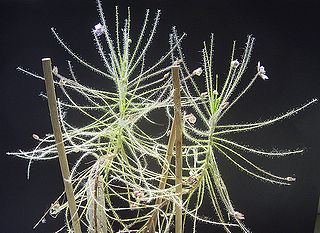
Byblis is a small genus of carnivorous plants, sometimes termed the rainbow plants for the attractive appearance of their mucilage-covered leaves in bright sunshine. Native to Australia and New Guinea, it is the only genus in the family Byblidaceae. The first species in the genus was described by the English botanist Richard Anthony Salisbury in 1808. Eight species are now recognised.

Roridula is a genus of evergreen, insect-trapping shrubs, with two species, of about 1⅓–2 m. It is the only genus in the family Roridulaceae. It has thin, woody, shyly branching, upright, initially brown, later grey stems, with lance- to awl-shaped leaves crowded at their tips. The star-symmetrical flowers consist from the outside in of five, green or reddish, free sepals, alternating with five white, pink or purple, free petals. Further to the middle and opposite the sepals are five stamens with the anthers initially kinked down. These suddenly flip up if the nectar-containing swelling at its base is being touched. The center of the flower is occupied by a superior ovary. The leaves and sepals carry many sticky tentacles of different sizes, that trap insects. Roridula does not break down the insect proteins, but bugs of the genus Pameridea prey on the trapped insects. These later deposit their feces on the leaves, which take up nutrients from the droppings. The species can be found in the Western Cape province of South Africa. They are commonly known as dewstick or fly bush in English and vlieëbos or vlieëbossie in Afrikaans.
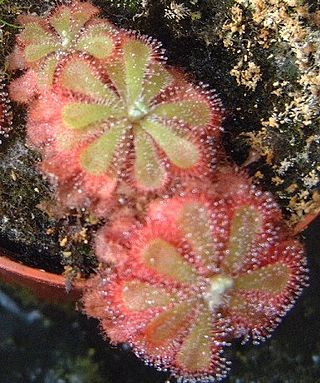
Drosera aliciae, the Alice sundew, is a carnivorous plant in the family Droseraceae. It is native to the Cape Provinces of South Africa, like Drosera capensis, the cape sundew, and is one of the most common sundews in cultivation. The plant forms small, tight rosettes of wedge-shaped leaves, up to 5 cm in diameter. Under conditions of good lighting, the insect-snagging tentacles will become deeply coloured with anthocyanin pigments, which probably aid in its attraction of insect prey. The plant is relatively easy to grow, and produces attractive scapes of pink flowers, which are held about 30 cm away from the carnivorous leaves, so as to prevent pollinators from becoming ensnared. D. aliciae is very similar in form to a number of other closely related species such as D. slackii, and D. natalensis: the former is rather larger with a slightly different growth habit(8 cm diameter); the latter has hairier stipules and a larger distance between leaf base and the “sticky” trichomes.

Drosera rotundifolia, the round-leaved sundew, roundleaf sundew, or common sundew, is a carnivorous species of flowering plant that grows in bogs, marshes and fens. One of the most widespread sundew species, it has a circumboreal distribution, being found in all of northern Europe, much of Siberia, large parts of northern North America, Korea and Japan but is also found as far south as California, Mississippi and Alabama in the United States of America and in New Guinea.

Drosera spatulata, the spoon-leaved sundew, is a variable, rosette-forming sundew with spoon-shaped leaves. The specific epithet is Latin for "spatula shaped," a reference to the form of the leaves. This sundew has a large range and occurs naturally throughout Southeast Asia, southern China and Japan, Micronesia, Papua New Guinea, eastern Australia, Tasmania and New Zealand. Variants are often known by the localities in which they are found. The plant does not form hibernacula in winter, and is easily grown using the same methods as Drosera capensis.

Drosera regia, commonly known as the king sundew, is a carnivorous plant in the sundew genus Drosera that is endemic to a single valley in South Africa. The genus name Drosera comes from the Greek word droseros, meaning "dew-covered". The specific epithet regia is derived from the Latin for "royal", a reference to the "striking appearance" of the species. Individual leaves can reach 70 cm (28 in) in length. It has many unusual relict characteristics not found in most other Drosera species, including woody rhizomes, operculate pollen, and the lack of circinate vernation in scape growth. All of these factors, combined with molecular data from phylogenetic analysis, contribute to the evidence that D. regia possesses some of the most ancient characteristics within the genus. Some of these are shared with the related Venus flytrap (Dionaea muscipula), which suggests a close evolutionary relationship.
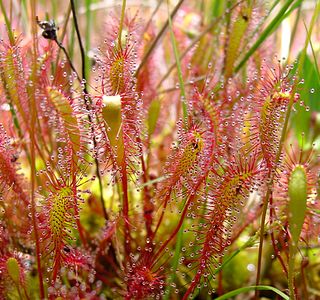
Drosera anglica, commonly known as the English sundew or great sundew, is a carnivorous flowering plant species belonging to the sundew family Droseraceae. It is a temperate species with a circumboreal range, although it does occur as far south as Japan, southern Europe, and the island of Kauai in Hawaii, where it grows as a tropical sundew. It is thought to originate from an amphidiploid hybrid of D. rotundifolia and D. linearis, meaning that a sterile hybrid between these two species doubled its chromosomes to produce fertile progeny which stabilized into the current D. anglica.

Drosera intermedia, commonly known as the oblong-leaved sundew, spoonleaf sundew, or spatulate leaved sundew, is an insectivorous plant species belonging to the sundew genus. It is a temperate or tropical species native to Europe, southeastern Canada, the eastern half of the United States, Cuba, Hispaniola, and northern South America.

A protocarnivorous plant, according to some definitions, traps and kills insects or other animals but lacks the ability to either directly digest or absorb nutrients from its prey like a carnivorous plant. The morphological adaptations such as sticky trichomes or pitfall traps of protocarnivorous plants parallel the trap structures of confirmed carnivorous plants.

Carnivorous plants are plants that derive some or most of their nutrients from trapping and consuming animals or protozoans, typically insects and other arthropods, and occasionally small mammals and birds. They still generate all of their energy from photosynthesis. They have adapted to grow in waterlogged sunny places where the soil is thin or poor in nutrients, especially nitrogen, such as acidic bogs. They can be found on all continents except Antarctica, as well as many Pacific islands. In 1875, Charles Darwin published Insectivorous Plants, the first treatise to recognize the significance of carnivory in plants, describing years of painstaking research.

Drosera glanduligera, commonly known as the pimpernel sundew or scarlet sundew, is a species of carnivorous plant endemic to southern Australia. It is an ephemeral annual plant that grows in the winter and flowers from August to November.

Drosera uniflora is a species in the carnivorous plant genus Drosera that is native to southern Chile, Argentina, and the Falkland Islands. It is a tiny sundew with a solitary white flower as its name would suggest. Stalked glands on its leaves, which secrete sticky mucilage at the tips, are used to capture and hold insect prey, from which the plant derives the nutrients it cannot obtain in sufficient quantity from the soil. It was formally described in 1809 by botanist Carl Ludwig Willdenow.

In botany, tentacles are glandular hairs on the leaves of some species of insectivorous plants such as Drosera (sundews). Tentacles are different from organs such as the tendrils of climbing plants.
The tissues that are concerned with the secretion of gums, resins, volatile oils, nectar latex, and other substances in plants are called secretory tissues. These tissues are classified as either laticiferous tissues or glandular tissues.

Steel trap is an informal term in the study of comparative plant physiology of the carnivorous plants. "Steel trap", more particularly "active steel trap", refers to prey capture devices such as occur in some members of the family Droseraceae, and in particular in the genera Dionaea and Aldrovanda ("waterwheel"). The term apparently originated with the author Francis Ernest Lloyd in 1942, in which he adopted the overly general term "steel trap" rather than say, "gin trap" or a more adjectival form, for devices such as the lobed trap leaves of Dionaea.
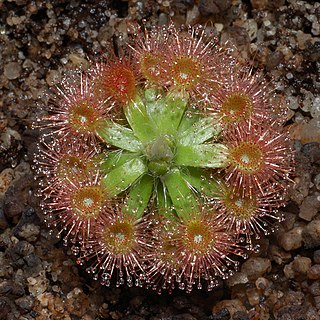
Drosera pulchella, a type of pygmy sundew , is a species of carnivorous plant native to southwestern Australia. As their common name suggests, they are a small species that usually 15 to 20 millimeters wide. They typically grow in clusters that completely cover an area like a patch of moss. The namesake sticky dew at the ends of their leaves is designed to trap insects so that the plants can absorb nutrients as the insect decomposes.
Toxomerus basalis, commonly known as the sundew flower fly, is a species of kleptoparasitic fly endemic to Brazil. It was first described by Francis Walker in 1836. It feeds on captured, immobilized insects caught on the sticky leaves of sundew plants, which are carnivorous. Adult flies seem to have some capacity to escape from Drosera leaves if they have not come into contact with too many of the tentacles. The species is non-specific and have been found on large-leaved, semi-erect, and thread-like Drosera species, such as Drosera graomogolensis and Drosera magnifica.
